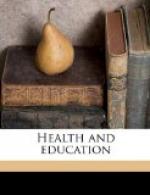“It is gladdening to remember that, in its utmost nobleness, the very temper which has been thought most averse to it, the Protestant temper of self-dependence and inquiry, were expressed in every case. Faith and aspiration there were in every Christian ecclesiastical building from the first century to the fifteenth: but the moral habits to which England in this age owes the kind of greatness which she has—the habits of philosophical investigation, of accurate thought, of domestic seclusion and independence, of stern self-reliance, and sincere upright searching into religious truth,—were only traceable in the features which were the distinctive creations of the Gothic schools, in the varied foliage and thorny fretwork, and shadowy niche, and buttressed pier, and fearless height of subtle pinnacle and crested tower, sent ‘like an unperplexed question up to heaven.’”
So says Mr. Ruskin. I, for one, endorse his gallant words. And I think that a strong proof of their truth is to be found in two facts, which seem at first paradoxical. First, that the new Roman Catholic churches on the Continent—I speak especially of France, which is the most highly cultivated Romanist country—are, like those which the Jesuits built in the seventeenth and eighteenth centuries, less and less Gothic. The former were sham-classic; the latter are rather of a new fantastic Romanesque, or rather Byzantinesque style, which is a real retrogression from Gothic towards earlier and less natural schools. Next, that the Puritan communions, the Kirk of Scotland and the English Nonconformists, as they are becoming more cultivated—and there are now many highly cultivated men among them—are introducing Gothic architecture more and more into their churches. There are elements in it, it seems, which do not contradict their Puritanism; elements which they can adapt to their own worship; namely, the very elements which Mr. Ruskin has discerned.
But if they can do so, how much more can we of the Church of England? As long as we go on where our medieval forefathers left off; as long as we keep to the most perfect types of their work, in waiting for the day when we shall be able to surpass them, by making our work even more naturalistic than theirs, more truly expressive of the highest aspirations of humanity: so long we are reverencing them, and that latent Protestantism in them, which produced at last the Reformation.
And if any should say—“Nevertheless, your Protestant Gothic church, though you made it ten times more beautiful, and more symbolic, than Cologne Minster itself, would still be a sham. For where would be your images? And still more, where would be your Host? Do you not know that in the medieval church the vistas of its arcades, the alternations of its lights and shadows, the gradations of its colouring, and all its carefully subordinated wealth of art, pointed to, were concentrated round, one sacred spot, as a curve, however vast its sweep though space, tends at every moment toward a single focus? And that spot, that focus, was, and is still, in every Romish church, the body of God, present upon the altar in the form of bread? Without Him, what is all your building? Your church is empty: your altar bare; a throne without a king; an eye-socket without an eye.”




